流媒体RTP协议
- 格式:doc
- 大小:55.00 KB
- 文档页数:12
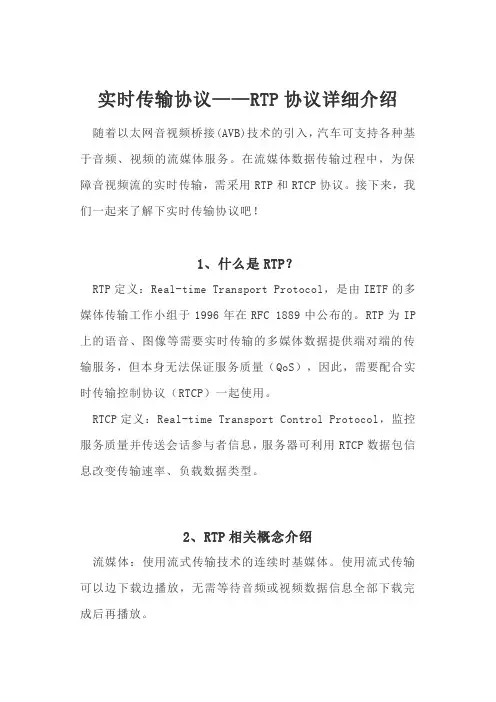
实时传输协议——RTP协议详细介绍随着以太网音视频桥接(AVB)技术的引入,汽车可支持各种基于音频、视频的流媒体服务。
在流媒体数据传输过程中,为保障音视频流的实时传输,需采用RTP和RTCP协议。
接下来,我们一起来了解下实时传输协议吧!1、什么是RTP?RTP定义:Real-time Transport Protocol,是由IETF的多媒体传输工作小组于1996年在RFC 1889中公布的。
RTP为IP 上的语音、图像等需要实时传输的多媒体数据提供端对端的传输服务,但本身无法保证服务质量(QoS),因此,需要配合实时传输控制协议(RTCP)一起使用。
RTCP定义:Real-time Transport Control Protocol,监控服务质量并传送会话参与者信息,服务器可利用RTCP数据包信息改变传输速率、负载数据类型。
2、RTP相关概念介绍流媒体:使用流式传输技术的连续时基媒体。
使用流式传输可以边下载边播放,无需等待音频或视频数据信息全部下载完成后再播放。
混频器(Mixer):一种中间系统,将一个或多个源的RTP数据包合成一个新的RTP数据包,然后转发出去。
混频器可能会改变数据包的数据格式,并对各个流组合的新数据包生成一个新SSRC。
转换器(Translator):一种中间系统,转发RTP数据包但不改变数据包的同步源标识符,可用于通过IP多播无法直接到达的用户区,如在防火墙两端使用转换器,外侧转换器通过安全连接将数据传输到内侧转换器。
RTP利用混频器和转换器完成实时数据传输,混频器接收来自一个或多个发送方的RTP数据包,并把它们组合成一个新的RTP 数据包继续转发。
这个组合数据包使用新的SSRC标识,组合数据包将作为新的发送方加入到RTP传输中。
混频器将不同的媒体流组合在一起,需要通过转换器来对单个媒体流进行操作,可进行编码转换或协议翻译。
典型的RTP数据包传输流程如下图所示,其中S1、S2、S3、S4是数据源的发送端,R4是RTP 数据包的接收端。

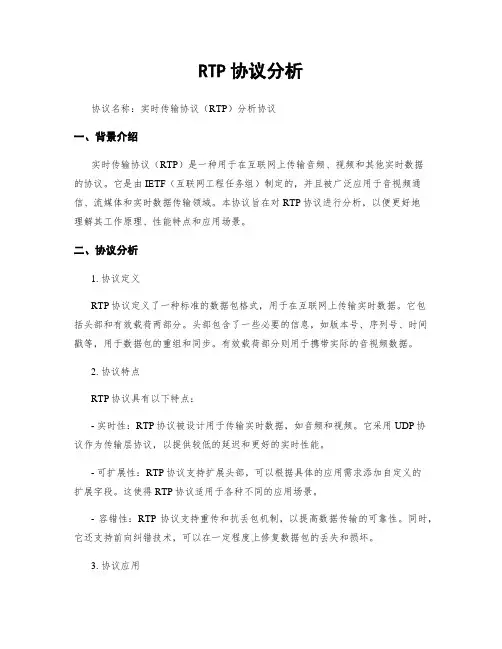
RTP协议分析协议名称:实时传输协议(RTP)分析协议一、背景介绍实时传输协议(RTP)是一种用于在互联网上传输音频、视频和其他实时数据的协议。
它是由IETF(互联网工程任务组)制定的,并且被广泛应用于音视频通信、流媒体和实时数据传输领域。
本协议旨在对RTP协议进行分析,以便更好地理解其工作原理、性能特点和应用场景。
二、协议分析1. 协议定义RTP协议定义了一种标准的数据包格式,用于在互联网上传输实时数据。
它包括头部和有效载荷两部分。
头部包含了一些必要的信息,如版本号、序列号、时间戳等,用于数据包的重组和同步。
有效载荷部分则用于携带实际的音视频数据。
2. 协议特点RTP协议具有以下特点:- 实时性:RTP协议被设计用于传输实时数据,如音频和视频。
它采用UDP协议作为传输层协议,以提供较低的延迟和更好的实时性能。
- 可扩展性:RTP协议支持扩展头部,可以根据具体的应用需求添加自定义的扩展字段。
这使得RTP协议适用于各种不同的应用场景。
- 容错性:RTP协议支持重传和抗丢包机制,以提高数据传输的可靠性。
同时,它还支持前向纠错技术,可以在一定程度上修复数据包的丢失和损坏。
3. 协议应用RTP协议广泛应用于以下领域:- 音视频通信:RTP协议被用于实现音频和视频的实时传输,如VoIP(网络电话)、视频会议等。
- 流媒体:RTP协议是流媒体传输的基础,通过将音视频数据打包成RTP数据包进行传输,实现了高效的流媒体传输。
- 实时数据传输:RTP协议也可以用于传输其他实时数据,如传感器数据、实时游戏数据等。
4. 协议性能分析为了评估RTP协议的性能,可以从以下几个方面进行分析:- 延迟:RTP协议采用UDP传输,相比于TCP,具有较低的传输延迟。
但是,由于网络的不确定性,RTP协议仍然可能面临一定的延迟问题。
可以通过测量数据包的传输时间来评估延迟性能。
- 丢包率:RTP协议支持重传和抗丢包机制,但是在网络条件较差的情况下,仍然可能发生数据包丢失的情况。
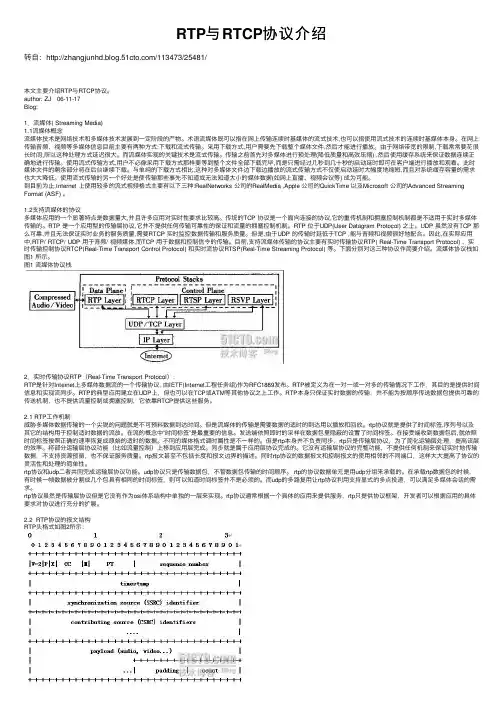
RTP与RTCP协议介绍转⾃:/113473/25481/本⽂主要介绍RTP与RTCP协议。
author: ZJ 06-11-17Blog:1.流媒体( Streaming Media)1.1流媒体概念流媒体技术是⽹络技术和多媒体技术发展到⼀定阶段的产物。
术语流媒体既可以指在⽹上传输连续时基媒体的流式技术,也可以指使⽤流式技术的连续时基媒体本⾝。
在⽹上传输⾳频、视频等多媒体信息⽬前主要有两种⽅式:下载和流式传输。
采⽤下载⽅式,⽤户需要先下载整个媒体⽂件,然后才能进⾏播放。
由于⽹络带宽的限制,下载常常要花很长时间,所以这种处理⽅式延迟很⼤。
⽽流媒体实现的关键技术是流式传输。
传输之前⾸先对多媒体进⾏预处理(降低质量和⾼效压缩) ,然后使⽤缓存系统来保证数据连续正确地进⾏传输。
使⽤流式传输⽅式,⽤户不必像采⽤下载⽅式那样要等到整个⽂件全部下载完毕,⽽是只需经过⼏秒到⼏⼗秒的启动延时即可在客户端进⾏播放和观看。
此时媒体⽂件的剩余部分将在后台继续下载。
与单纯的下载⽅式相⽐,这种对多媒体⽂件边下载边播放的流式传输⽅式不仅使启动延时⼤幅度地缩短,⽽且对系统缓存容量的需求也⼤⼤降低。
使⽤流式传输的另⼀个好处是使传输那些事先不知道或⽆法知道⼤⼩的媒体数据(如⽹上直播、视频会议等) 成为可能。
到⽬前为⽌,Internet 上使⽤较多的流式视频格式主要有以下三种:RealNetworks 公司的RealMedia ,Apple 公司的QuickTime 以及Microsoft 公司的Advanced Streaming Format (ASF) 。
1.2⽀持流媒体的协议多媒体应⽤的⼀个显著特点是数据量⼤,并且许多应⽤对实时性要求⽐较⾼。
传统的TCP 协议是⼀个⾯向连接的协议,它的重传机制和拥塞控制机制都是不适⽤于实时多媒体传输的。
RTP 是⼀个应⽤型的传输层协议,它并不提供任何传输可靠性的保证和流量的拥塞控制机制。
RTP 位于UDP(User Datagram Protocol) 之上。
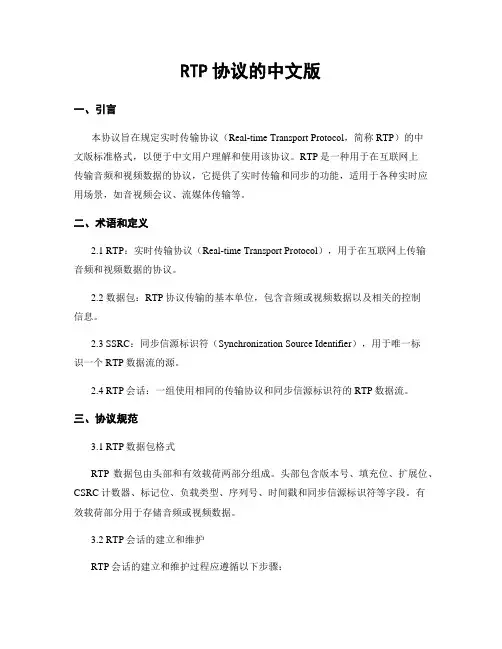
RTP协议的中文版一、引言本协议旨在规定实时传输协议(Real-time Transport Protocol,简称RTP)的中文版标准格式,以便于中文用户理解和使用该协议。
RTP是一种用于在互联网上传输音频和视频数据的协议,它提供了实时传输和同步的功能,适用于各种实时应用场景,如音视频会议、流媒体传输等。
二、术语和定义2.1 RTP:实时传输协议(Real-time Transport Protocol),用于在互联网上传输音频和视频数据的协议。
2.2 数据包:RTP协议传输的基本单位,包含音频或视频数据以及相关的控制信息。
2.3 SSRC:同步信源标识符(Synchronization Source Identifier),用于唯一标识一个RTP数据流的源。
2.4 RTP会话:一组使用相同的传输协议和同步信源标识符的RTP数据流。
三、协议规范3.1 RTP数据包格式RTP数据包由头部和有效载荷两部分组成。
头部包含版本号、填充位、扩展位、CSRC计数器、标记位、负载类型、序列号、时间戳和同步信源标识符等字段。
有效载荷部分用于存储音频或视频数据。
3.2 RTP会话的建立和维护RTP会话的建立和维护过程应遵循以下步骤:3.2.1 客户端向服务器发送请求,请求建立RTP会话。
3.2.2 服务器接收到请求后,生成一个唯一的同步信源标识符(SSRC)并返回给客户端。
3.2.3 客户端收到服务器返回的SSRC后,将其作为该会话的标识符,并开始发送RTP数据包。
3.2.4 服务器接收到客户端发送的RTP数据包后,根据SSRC标识符进行数据处理和同步。
3.3 RTP数据包的传输和接收RTP数据包的传输和接收过程应遵循以下步骤:3.3.1 发送方将音频或视频数据封装成RTP数据包,并通过网络发送给接收方。
3.3.2 接收方接收到RTP数据包后,根据头部中的同步信源标识符(SSRC)进行数据处理和同步。
3.3.3 接收方根据RTP数据包的时间戳信息,恢复音频或视频数据,并进行播放或显示。
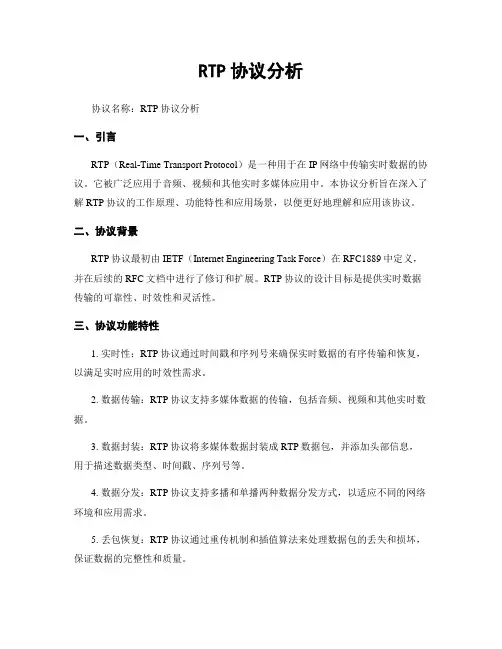
RTP协议分析协议名称:RTP协议分析一、引言RTP(Real-Time Transport Protocol)是一种用于在IP网络中传输实时数据的协议。
它被广泛应用于音频、视频和其他实时多媒体应用中。
本协议分析旨在深入了解RTP协议的工作原理、功能特性和应用场景,以便更好地理解和应用该协议。
二、协议背景RTP协议最初由IETF(Internet Engineering Task Force)在RFC1889中定义,并在后续的RFC文档中进行了修订和扩展。
RTP协议的设计目标是提供实时数据传输的可靠性、时效性和灵活性。
三、协议功能特性1. 实时性:RTP协议通过时间戳和序列号来确保实时数据的有序传输和恢复,以满足实时应用的时效性需求。
2. 数据传输:RTP协议支持多媒体数据的传输,包括音频、视频和其他实时数据。
3. 数据封装:RTP协议将多媒体数据封装成RTP数据包,并添加头部信息,用于描述数据类型、时间戳、序列号等。
4. 数据分发:RTP协议支持多播和单播两种数据分发方式,以适应不同的网络环境和应用需求。
5. 丢包恢复:RTP协议通过重传机制和插值算法来处理数据包的丢失和损坏,保证数据的完整性和质量。
6. 流同步:RTP协议通过同步源标识符(SSRC)和时间戳来实现多个数据流的同步播放。
四、协议工作流程1. 数据封装:发送端将多媒体数据封装成RTP数据包,并添加RTP头部信息。
2. 数据传输:发送端通过UDP协议将RTP数据包发送到目标地址。
3. 数据接收:接收端接收到RTP数据包后,解析RTP头部信息,并根据时间戳和序列号进行数据恢复和重组。
4. 数据播放:接收端根据时间戳和序列号将数据包按正确的顺序播放或呈现。
五、协议应用场景1. 实时音视频通信:RTP协议被广泛应用于音视频通信领域,如VoIP(Voice over IP)、视频会议等。
2. 流媒体传输:RTP协议可用于流媒体传输,如实时直播、点播等。
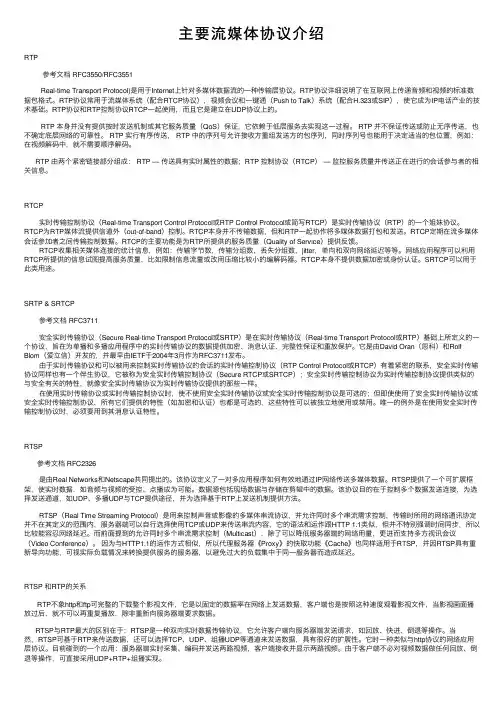
主要流媒体协议介绍RTP参考⽂档 RFC3550/RFC3551Real-time Transport Protocol)是⽤于Internet上针对多媒体数据流的⼀种传输层协议。
RTP协议详细说明了在互联⽹上传递⾳频和视频的标准数据包格式。
RTP协议常⽤于流媒体系统(配合RTCP协议),视频会议和⼀键通(Push to Talk)系统(配合H.323或SIP),使它成为IP电话产业的技术基础。
RTP协议和RTP控制协议RTCP⼀起使⽤,⽽且它是建⽴在UDP协议上的。
RTP 本⾝并没有提供按时发送机制或其它服务质量(QoS)保证,它依赖于低层服务去实现这⼀过程。
RTP 并不保证传送或防⽌⽆序传送,也不确定底层⽹络的可靠性。
RTP 实⾏有序传送, RTP 中的序列号允许接收⽅重组发送⽅的包序列,同时序列号也能⽤于决定适当的包位置,例如:在视频解码中,就不需要顺序解码。
RTP 由两个紧密链接部分组成: RTP ―传送具有实时属性的数据;RTP 控制协议(RTCP)―监控服务质量并传送正在进⾏的会话参与者的相关信息。
RTCP实时传输控制协议(Real-time Transport Control Protocol或RTP Control Protocol或简写RTCP)是实时传输协议(RTP)的⼀个姐妹协议。
RTCP为RTP媒体流提供信道外(out-of-band)控制。
RTCP本⾝并不传输数据,但和RTP⼀起协作将多媒体数据打包和发送。
RTCP定期在流多媒体会话参加者之间传输控制数据。
RTCP的主要功能是为RTP所提供的服务质量(Quality of Service)提供反馈。
RTCP收集相关媒体连接的统计信息,例如:传输字节数,传输分组数,丢失分组数,jitter,单向和双向⽹络延迟等等。
⽹络应⽤程序可以利⽤RTCP所提供的信息试图提⾼服务质量,⽐如限制信息流量或改⽤压缩⽐较⼩的编解码器。
RTCP本⾝不提供数据加密或⾝份认证。
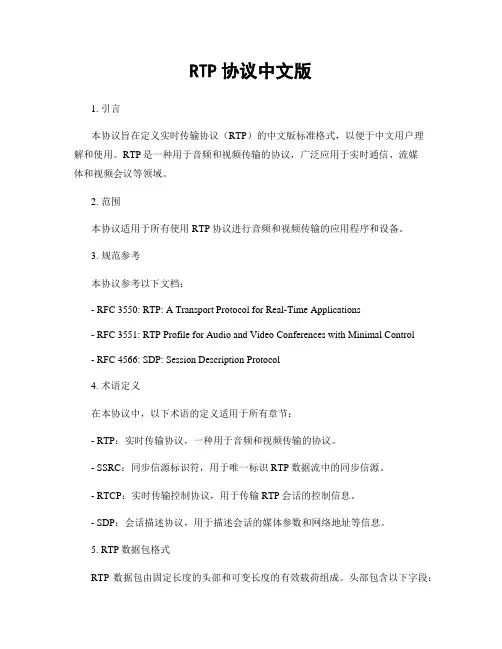
RTP协议中文版1. 引言本协议旨在定义实时传输协议(RTP)的中文版标准格式,以便于中文用户理解和使用。
RTP是一种用于音频和视频传输的协议,广泛应用于实时通信、流媒体和视频会议等领域。
2. 范围本协议适用于所有使用RTP协议进行音频和视频传输的应用程序和设备。
3. 规范参考本协议参考以下文档:- RFC 3550: RTP: A Transport Protocol for Real-Time Applications- RFC 3551: RTP Profile for Audio and Video Conferences with Minimal Control- RFC 4566: SDP: Session Description Protocol4. 术语定义在本协议中,以下术语的定义适用于所有章节:- RTP:实时传输协议,一种用于音频和视频传输的协议。
- SSRC:同步信源标识符,用于唯一标识RTP数据流中的同步信源。
- RTCP:实时传输控制协议,用于传输RTP会话的控制信息。
- SDP:会话描述协议,用于描述会话的媒体参数和网络地址等信息。
5. RTP数据包格式RTP数据包由固定长度的头部和可变长度的有效载荷组成。
头部包含以下字段:- 版本(V):协议版本号,占2位。
- 填充(P):指示数据包是否有填充字节,占1位。
- 扩展(X):指示数据包是否包含扩展头部,占1位。
- CSRC计数(CC):指示CSRC标识符的数量,占4位。
- 标记(M):用于指示数据包是否为关键帧,占1位。
- 负载类型(PT):指示有效载荷类型,占7位。
- 序列号(SN):用于标识RTP数据包的顺序,占16位。
- 时间戳(TS):用于同步RTP数据流的时间戳,占32位。
- 同步信源标识符(SSRC):用于唯一标识RTP数据流中的同步信源,占32位。
- CSRC标识符(CSRC):用于标识参与混合的源,每个CSRC标识符占32位。
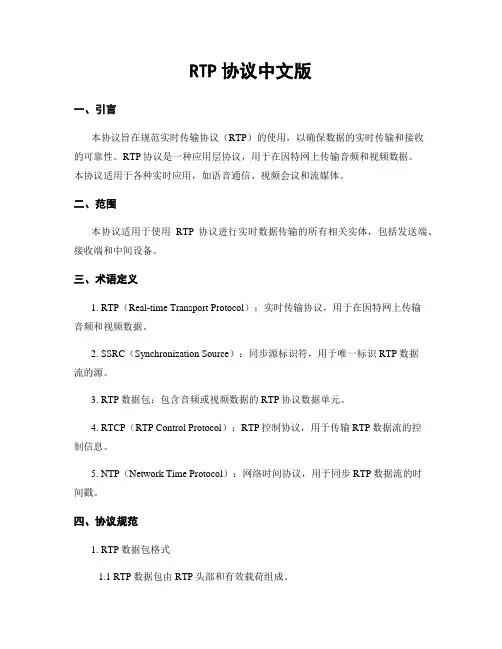
RTP协议中文版一、引言本协议旨在规范实时传输协议(RTP)的使用,以确保数据的实时传输和接收的可靠性。
RTP协议是一种应用层协议,用于在因特网上传输音频和视频数据。
本协议适用于各种实时应用,如语音通信、视频会议和流媒体。
二、范围本协议适用于使用RTP协议进行实时数据传输的所有相关实体,包括发送端、接收端和中间设备。
三、术语定义1. RTP(Real-time Transport Protocol):实时传输协议,用于在因特网上传输音频和视频数据。
2. SSRC(Synchronization Source):同步源标识符,用于唯一标识RTP数据流的源。
3. RTP数据包:包含音频或视频数据的RTP协议数据单元。
4. RTCP(RTP Control Protocol):RTP控制协议,用于传输RTP数据流的控制信息。
5. NTP(Network Time Protocol):网络时间协议,用于同步RTP数据流的时间戳。
四、协议规范1. RTP数据包格式1.1 RTP数据包由RTP头部和有效载荷组成。
1.2 RTP头部包含以下字段:- 版本号:指示RTP协议的版本。
- 填充位:用于填充RTP头部,以满足特定的传输要求。
- 扩展位:用于指示RTP头部是否包含扩展字段。
- CSRC计数器:指示CSRC列表的长度。
- 标识位:用于指示RTP数据包的类型。
- 序列号:用于标识RTP数据包的顺序。
- 时间戳:用于同步RTP数据流的时间。
- SSRC:用于唯一标识RTP数据流的源。
1.3 有效载荷可以是音频或视频数据。
2. RTP数据传输2.1 RTP数据包通过UDP协议进行传输。
2.2 发送端将RTP数据包封装为UDP数据包,并通过网络发送给接收端。
2.3 接收端接收UDP数据包,并将其解析为RTP数据包。
2.4 接收端根据RTP头部中的时间戳信息进行数据同步和播放。
3. RTCP控制3.1 RTCP协议用于传输RTP数据流的控制信息。
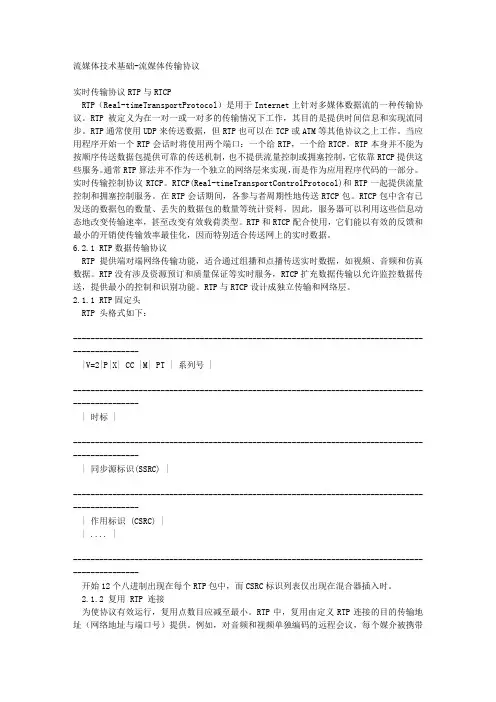
流媒体技术基础-流媒体传输协议实时传输协议RTP与RTCPRTP(Real-timeTransportProtocol)是用于Internet上针对多媒体数据流的一种传输协议。
RTP被定义为在一对一或一对多的传输情况下工作,其目的是提供时间信息和实现流同步。
RTP通常使用UDP来传送数据,但RTP也可以在TCP或ATM等其他协议之上工作。
当应用程序开始一个RTP会话时将使用两个端口:一个给RTP,一个给RTCP。
RTP本身并不能为按顺序传送数据包提供可靠的传送机制,也不提供流量控制或拥塞控制,它依靠RTCP提供这些服务。
通常RTP算法并不作为一个独立的网络层来实现,而是作为应用程序代码的一部分。
实时传输控制协议RTCP。
RTCP(Real-timeTransportControlProtocol)和RTP一起提供流量控制和拥塞控制服务。
在RTP会话期间,各参与者周期性地传送RTCP包。
RTCP包中含有已发送的数据包的数量、丢失的数据包的数量等统计资料,因此,服务器可以利用这些信息动态地改变传输速率,甚至改变有效载荷类型。
RTP和RTCP配合使用,它们能以有效的反馈和最小的开销使传输效率最佳化,因而特别适合传送网上的实时数据。
6.2.1 RTP数据传输协议RTP提供端对端网络传输功能,适合通过组播和点播传送实时数据,如视频、音频和仿真数据。
RTP没有涉及资源预订和质量保证等实时服务,RTCP扩充数据传输以允许监控数据传送,提供最小的控制和识别功能。
RTP与RTCP设计成独立传输和网络层。
2.1.1 RTP固定头RTP 头格式如下:-----------------------------------------------------------------------------------------------|V=2|P|X| CC |M| PT | 系列号 |-----------------------------------------------------------------------------------------------| 时标 |-----------------------------------------------------------------------------------------------| 同步源标识(SSRC) |-----------------------------------------------------------------------------------------------| 作用标识 (CSRC) || .... |-----------------------------------------------------------------------------------------------开始12个八进制出现在每个RTP包中,而CSRC标识列表仅出现在混合器插入时。
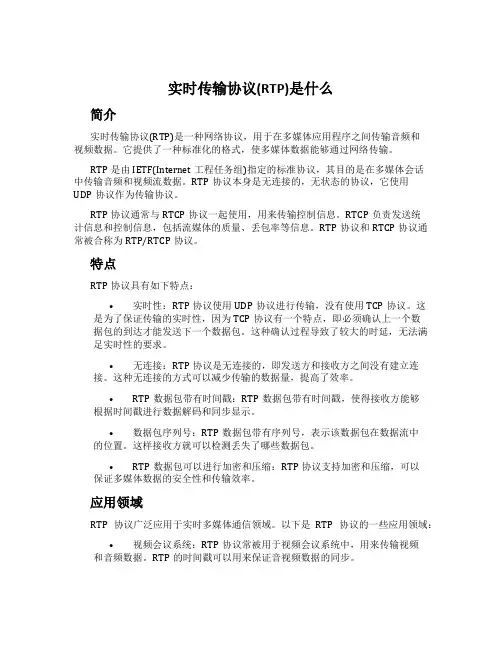
实时传输协议(RTP)是什么简介实时传输协议(RTP)是一种网络协议,用于在多媒体应用程序之间传输音频和视频数据。
它提供了一种标准化的格式,使多媒体数据能够通过网络传输。
RTP是由IETF(Internet工程任务组)指定的标准协议,其目的是在多媒体会话中传输音频和视频流数据。
RTP协议本身是无连接的,无状态的协议,它使用UDP协议作为传输协议。
RTP协议通常与RTCP协议一起使用,用来传输控制信息。
RTCP负责发送统计信息和控制信息,包括流媒体的质量、丢包率等信息。
RTP协议和RTCP协议通常被合称为RTP/RTCP协议。
特点RTP协议具有如下特点:•实时性:RTP协议使用UDP协议进行传输,没有使用TCP协议。
这是为了保证传输的实时性,因为TCP协议有一个特点,即必须确认上一个数据包的到达才能发送下一个数据包。
这种确认过程导致了较大的时延,无法满足实时性的要求。
•无连接:RTP协议是无连接的,即发送方和接收方之间没有建立连接。
这种无连接的方式可以减少传输的数据量,提高了效率。
•RTP数据包带有时间戳:RTP数据包带有时间戳,使得接收方能够根据时间戳进行数据解码和同步显示。
•数据包序列号:RTP数据包带有序列号,表示该数据包在数据流中的位置。
这样接收方就可以检测丢失了哪些数据包。
•RTP数据包可以进行加密和压缩:RTP协议支持加密和压缩,可以保证多媒体数据的安全性和传输效率。
应用领域RTP协议广泛应用于实时多媒体通信领域。
以下是RTP协议的一些应用领域:•视频会议系统:RTP协议常被用于视频会议系统中,用来传输视频和音频数据。
RTP的时间戳可以用来保证音视频数据的同步。
•流媒体系统:RTP协议常被用于流媒体系统中,比如实时流媒体直播、点播等。
•视频监控系统:RTP协议能够提供实时的视频流数据传输,可以被用于视频监控系统中,比如公共安全领域的视频监控。
总结RTP协议是一种用于传输音频和视频数据的网络协议,它具有实时性、无连接、数据包带有时间戳和序列号等特点。
RTP协议中文版1. 引言本协议旨在定义实时传输协议(Real-time Transport Protocol,以下简称RTP)的中文版标准格式,以便于在中文环境下进行协议撰写和使用。
RTP是一种用于实时传输音频和视频数据的协议,广泛应用于音视频通信、流媒体传输等领域。
2. 术语和定义2.1 实时传输协议(RTP)实时传输协议是一种用于在互联网上传输实时数据的协议,可以提供时间戳、序列号、负载类型等信息,以保证数据的实时性和完整性。
2.2 数据包(Packet)数据包是RTP协议中的基本单位,包含了音频或者视频数据以及相关的控制信息。
2.3 时间戳(Timestamp)时间戳是RTP数据包中用于表示数据产生时间的数值,以毫秒为单位。
2.4 序列号(Sequence Number)序列号是RTP数据包中用于标识数据包的顺序的数值,每一个数据包都有惟一的序列号。
2.5 负载类型(Payload Type)负载类型用于标识RTP数据包中所携带的数据的类型,例如音频、视频等。
3. 协议格式3.1 RTP报头RTP报头包含了一些重要的字段,用于描述RTP数据包的信息。
报头的格式如下:0 1 2 30 1 2 3 4 5 6 7 8 9 0 1 2 3 4 5 6 7 8 9 0 1 2 3 4 5 6 7 8 9 0 1+-+-+-+-+-+-+-+-+-+-+-+-+-+-+-+-+-+-+-+-+-+-+-+-+-+-+-+-+-+-+-+-+|V=2|P|X| CC |M| PT | Sequence Number |+-+-+-+-+-+-+-+-+-+-+-+-+-+-+-+-+-+-+-+-+-+-+-+-+-+-+-+-+-+-+-+-+| Timestamp |+-+-+-+-+-+-+-+-+-+-+-+-+-+-+-+-+-+-+-+-+-+-+-+-+-+-+-+-+-+-+-+-+| Synchronization Source (SSRC) identifier |+=+=+=+=+=+=+=+=+=+=+=+=+=+=+=+=+=+=+=+=+=+=+=+=+=+=+=+=+=+=+=+ | Contributing Source (CSRC) identifiers || .... |+-+-+-+-+-+-+-+-+-+-+-+-+-+-+-+-+-+-+-+-+-+-+-+-+-+-+-+-+-+-+-+-+其中,各字段的含义如下:- V:协议版本号,当前为2。
RTP协议的中文版一、引言本协议旨在规范实时传输协议(Real-time Transport Protocol,简称RTP)的中文版,以便更好地满足中文用户的需求。
RTP是一种用于在互联网上传输音频和视频数据的协议,广泛应用于语音通话、视频会议、流媒体等领域。
本协议将详细描述RTP协议的中文版的基本原理、数据格式、传输机制等内容。
二、术语和定义1. RTP:实时传输协议(Real-time Transport Protocol),用于音频和视频数据的传输。
2. SSRC:同步信源标识符(Synchronization Source Identifier),用于唯一标识RTP数据流的源。
3. RTP包:由RTP头部和有效载荷组成的数据单元。
4. RTP头部:包含RTP版本、标识位、序列号、时间戳等信息的固定长度头部。
5. RTP有效载荷:音频或视频数据。
三、RTP协议的中文版规范1. RTP版本RTP协议的中文版采用RTP协议的最新版本,目前为RTP 2.0。
2. RTP头部格式RTP头部格式与RTP协议保持一致,包括RTP版本、标识位、序列号、时间戳等字段。
唯一的区别是,RTP协议的中文版将头部字段的名称和描述进行了中文化处理,以方便中文用户理解和使用。
3. SSRC的生成规则RTP协议的中文版规定SSRC的生成规则如下:- 首先,根据发送者的唯一标识生成一个随机数。
- 其次,将发送者的唯一标识与随机数进行哈希运算,得到一个32位的整数。
- 最后,将该整数作为SSRC的值。
4. RTP包的传输机制RTP协议的中文版采用UDP作为传输协议,以保证实时性。
为了提高传输效率,可以采用RTP扩展头部和压缩算法等技术。
5. RTP有效载荷的格式RTP协议的中文版支持多种音频和视频编码格式,包括但不限于G.711、G.722、H.264等。
具体的有效载荷格式需要根据实际应用需求进行选择。
6. RTP会话的建立和维护RTP协议的中文版建议使用SDP(Session Description Protocol)来描述和协商会话参数,包括媒体类型、传输协议、编码格式等。
RTP,RTCP,RTSP协议介绍流媒体是边下载边播放的⽅式, 是视频会议、IP电话等应⽤场合的技术基础。
为什么TCP/IP协议就不能满⾜多媒体通信的要求呢?因为TCP有以下4个特点:1.TCP重传机制2.TCP拥塞控制机制3.TCP报⽂头⽐UDP报⽂头要⼤4.TCP的启动速度慢对⽐:IP:数据传输 RTP:多媒体数据实时传输TCP:保证数据传输可靠 RTCP:保证多媒体数据传输的可靠RTP提供时间标志,序列号以及其他能够保证在实时数据传输时处理时间的⽅法RTCP是RTP的控制部分,是⽤来保证服务质量和成员管理的RTSP具体数据传输交给RTP,提供对流的远程控制RSVP预留带宽,提⾼QoS(Quality of Sever)RTP通常使⽤UDP来传送数据,但RTP也可以在TCP或ATM等其他协议之上⼯作。
当应⽤程序开始⼀个RTP会话时将使⽤两个端⼝:⼀个给RTP,⼀个给RTCP(RTP port + 1). RTP本⾝并不能为按顺序传送数据包提供可靠的传送机制,也不提供流量控制或拥塞控制,它依靠RTCP提供这些服务。
通常RTP算法并不作为⼀个独⽴的⽹络层来实现,⽽是作为应⽤程序代码的⼀部分。
RTSP与RTP最⼤的区别在于:RTSP是⼀种双向实时数据传输协议,它允许客户端向服务器端发送请求,如回放、快进、倒退等操作。
RTSP可基于RTP来传送数据,还可以选择TCP、UDP、组播UDP等通道来发送数据,具有很好的扩展性。
RTSP 默认使⽤554端⼝, ⾮常类似 HTTP 协议的流控制协议, rtsp 的命令总是按照顺序来发送.RTP/RTCP -------------------------RFC3550/RFC3551RTSP --------------------------RFC23262.1 RTP数据协议RTP 为实时应⽤提供端到端的运输,但不提供任何服务质量的保证,服务质量由RTCP来提供。
RTP协议分析一.RTP协议背景 (2)二.RTP协议原理及工作机制 (3)2.1 RTP协议原理 (4)2.1.1 RTP协议原理 (4)2.1.2 RTCP协议原理 (4)2.2 RTP数据包格式 (5)2.2.1 RTP数据包格式 (5)2.2.2 RTCP数据包格式 (8)2.3 RTP工作机制 (12)2.3.1 RTP工作机制 (12)2.3.2 RTCP工作机制 (12)三.RTP协议关键技术指标 (13)3.1 时间戳 (13)3.2时延 (14)3.3 抖动 (15)3.4丢包率 (15)3.5 会话和流两级分用 (16)3.6 多种流同步控制 (16)四.RTP协议应用方案 (17)4.1 RTP协议应用方案之单播 (17)4.2 RTP协议应用方案之广播 (17)4.3 RTP协议应用方案之组播 (17)4.3.1 RTP协议组播方案总体概述 (18)4.3.2 RTP协议组播方案服务器端实现 (19)4.3. 3RTP协议组播方案客户端实现 (20)4.3. 4RTP协议视频帧率和质量调整策略 (21)五.RTP协议移植计划 (22)六.RTP协议安全方面考虑 (22)一.RTP协议背景流(Streaming)是近年在Internet上出现的新概念,其定义非常广泛,主要是指通过网络传输多媒体数据的技术总称。
流媒体包含广义和狭义两种内涵:广义上的流媒体指的是使音频和视频形成稳定和连续的传输流和回放流的一系列技术、方法和协议的总称,即流媒体技术;狭义上的流媒体是相对于传统的下载-回放方式而言的,指的是一种从Internet上获取音频和视频等多媒体数据的新方法,它能够支持多媒体数据流的实时传输和实时播放。
通过运用流媒体技术,服务器能够向客户机发送稳定和连续的多媒体数据流,客户机在接收数据的同时以一个稳定的速率回放,而不用等数据全部下载完之后再进行回放。
流式传输有顺序流式传输(Progressive Streaming)和实时流式传输(Realtime Streaming)两种方式。
RTP(Real-time Transport Protocol)协议是一种实时传输协议,用于在网络上传输多媒体数据,如音频、视频和语音等。
它的原理是按照RTP数据包格式来封装流媒体数据,并利用与它绑定的协议进行数据包的传输。
在传输过程中,RTP协议从上层接收流媒体信息码流(如H.263),封装成RTP数据包,然后将RTP数据包发往UDP端口对中偶数端口;RTCP将RTCP控制包发往UDP端口对中的奇数端口(偶数的UDP端口+1)。
RTP协议的流程包括以下几个步骤:
1. 建立RTP会话:应用程序确定一对目的传输地址,包括一个网络地址和两个端口,分别用于发送RTP包和RTCP包。
2. 封装RTP数据包和RTCP控制包:RTP协议从上层接收流媒体信息码流,并将其封装为RTP数据包;RTCP从上层接收控制信息,并将其封装为RTCP控制包。
3. 发送RTP数据包和RTCP控制包:RTP将RTP数据包发往UDP端口对中的偶数端口,RTCP将RTCP控制包发往UDP端口对中的奇数端口。
在实际应用中,RTP协议通常与RTCP(Real-time Transport Control Protocol)协议一起使用,RTCP负责向会话中的所有成员周期性地发送控制包,以实现对服务质量的控制和对网络状况的诊断。
rtp 协议实时传输协议(RTP)是一种用于实时传输音频和视频数据的协议。
它既可以单独使用,也可以与其他协议(如RTSP)一起使用。
RTP的设计目标是提供一种低延迟、鲁棒性强的传输机制,以便实时应用程序(例如视频会议、流媒体)能够在网络中传输和接收音频和视频数据。
RTP使用UDP作为底层传输协议,这是因为UDP相比于TCP更适合实时数据传输。
UDP无连接、不可靠的特性使得RTP能够快速传递数据,并且不需要建立和维护复杂的连接。
RTP协议主要由两部分组成:RTP头和有效载荷。
RTP头包含了一些元数据信息,例如时间戳、序列号和负载类型。
时间戳用于同步媒体数据的播放,序列号用于保证数据的可靠传输。
负载类型指示了有效载荷的编码格式(例如PCM、MPEG)。
有效载荷部分是实际的音频或视频数据。
RTP协议本身并不负责对有效载荷进行编码或压缩,这是应用程序的责任。
RTP协议只负责将有效载荷封装在UDP数据包中,并添加一些元数据信息。
RTP协议还支持一些扩展功能,例如支持多路复用、混流和重传。
通过多路复用,可以在一个RTP流中传输多个音频或视频通道。
混流允许将多个RTP流合并成一个流,这对于实时会议和直播非常有用。
重传功能通过发送端发送冗余数据来提高数据传输的可靠性。
在RTP协议的传输过程中,需要注意一些问题。
首先是丢包问题,由于UDP的不可靠性,可能会导致数据包的丢失。
为了解决这个问题,可以使用前向纠错或重传机制。
其次是时延问题,由于RTP头的添加,会增加数据包的大小,导致延迟增加。
为了减少延迟,可以使用压缩和流水线技术。
总的来说,RTP协议是一种适用于实时传输音频和视频数据的协议。
它提供了一种低延迟、鲁棒性强的传输机制,能够满足实时应用程序对数据传输的需求。
但是,由于UDP的不可靠性,还需要在实际应用中采取一些措施来解决丢包和时延问题。
Standard Elements of RTPThe primary standard for audio/video transport in IP networks is the Real-time Transport Protocol (RTP), along with associated profiles and payload formats. RTP was developed by the Audio/Video Transport working group of the Internet Engineering Task Force (IETF), and it has since been adopted by the International Telecommunications Union (ITU) as part of its H.323 series of recommendations, and by several other standards organizations. RTP provides a framework for the transport of real-time media and needs to be profiled for particular uses before it is complete. The RTP profile for audio and video conferences with minimal control was standardized along with RTP, and several more profiles are under development. Each profile is accompanied by several payload format specifications, each of which describes the transport of a particular media format.The RTP SpecificationRTP was published as an IETF proposed standard (RFC 1889) in January 1996,HTPU6UTPH and its revision for draft standard status is almost complete.HTPU50UTPH The first revision of ITU recommendation H.323 included a verbatim copy of the RTP specification; later revisions reference the current IETF standard.RTP typically sits on top of UDP/IP transport, enhancing that transport with loss detection and reception quality reporting, provision for timing recovery and synchronization, payload and source identification, and marking of significant events within the media stream. Most implementations of RTP are part of an application or library that is layered above the UDP/IP sockets interface provided by the operating system. This is not the only possible design, though, and nothing in the RTP protocol requires UDP or IP. For example, some implementations layer RTP above TCP/IP, and others use RTP on non-IP networks, such as Asynchronous Transfer Mode (ATM)networks.There are two parts to RTP: the Tdata transfer protocolT and an associated Tcontrol protocolT. The RTP data transfer protocol manages delivery of real-time data, such as audio and video, between end systems. It defines an additional level of framing for the media payload, incorporating a sequence number for loss detection, timestamp to enable timing recovery, payload type and source identifiers, and a marker for significant events within the media stream. Also specified are rules for In the IETF standards process,HTPU8UTPH a specification undergoes a development cycle in which multiple TInternet draftsT are produced as the details of the design are worked out. When the design is complete, it is published as a Tproposed standardT RFC. A proposed standard is generally considered stable, with all known design issues worked out, and suitable for implementation. If that proposed standard proves useful, and if there are independent and interoperable implementations of each feature of that standard, it can then be advanced to Tdraft standardT status (possibly involving changes to correct any problems found in the proposed standard). Finally, after extensive experience, it may be published as a full TstandardT RFC. Advancement beyond proposed standard status is a significant hurdle that many protocols never achieve. timestamp and sequence number usage, although these rules are somewhat dependent on the profile and payload format in use, and for multiplexing multiple streams within a session. The RTP data transfer protocol is discussed further in HTUChapter 4UTH.The RTP control protocol (RTCP) provides reception quality feedback, participant identification, and synchronization between media streams. RTCP runs alongside RTP and provides periodic reporting of this information. Although data packets are typically sent every few milliseconds, the control protocol operates on the scale of seconds. The information sent in RTCP is necessary for synchronization between media streams—for example, for lip synchronization between audio and video—and can be useful for adapting the transmission according to reception quality feedback, and for identifying the participants. The RTP control protocol is discussedfurther in HTUChapter 5UTH.RTP supports the notion of TmixersT and TtranslatorsT, middle boxes that can operate on the media as it flows between endpoints. These may be used to translate an RTP session between different lower-layer protocols—for example, bridging between participants on IPv4 and IPv6 networks, or bringing a unicast-only participant into a multicast group. They can also adapt a media stream in some way—for example, transcoding the data format to reduce the bandwidth, or mixing multiple streams together.It is hard to place RTP in the OSI reference model. It performs many of the tasks typically assigned to a transport-layer protocol, yet it is not a complete transport in itself. RTP also performs some tasks of the session layer (spanning disparate transport connections and managing participant identification in a transport-neutral manner) and of the presentation layer (defining standard representations for media data).RTP ProfilesIt is important to be aware of the limits of the RTP protocol specification because it is deliberately incomplete in two ways. First, the standard does not specify algorithms for media playout and timing regeneration, synchronization between media streams, error concealment and correction, or congestion control. These are properly the province of the application designer, and because different applications have different needs, it would be foolish for the standard to mandate a single behavior. It does, of course, provide the necessary information for these algorithms to operate when they have been specified. Later chapters will discuss application design and the trade-offs inherent in providing these features.Second, some details of the transport are left open to modification by profiles and payload format definitions. These include features such as the resolution of the timestamps, marking of interesting events within a media stream, and use of the payload type field. The features that can be specified by RTP profiles include thefollowing:• Mapping between the payload type identifier in the RTP header and the payload format specifications (which describe how individual media codecs are to be used with RTP). Each profile will reference multiple payload formats and may indicate how particular signaling protocols (for example, SDPHTPU15UTPH) are used to describe the mapping.• The size of the payload type identifier field in the RTP header, and the number of bits used to mark events of interest within a media stream.• Additions to the fix ed RTP data transfer protocol header, if that header proves insufficient for a particular class of application.• The reporting interval for the RTP control protocol—for example, to make feedback more timely at the expense of additional overhead.• Limit ations on the RTCP packet types that are to be used, if some of the information provided is not useful to that class of applications. In addition, a profile may define extensions to RTCP to report additional information.• Additional security mechanisms—for example, new encryption and authentication algorithms.• Mapping of RTP and RTCP onto lower-layer transport protocols.At the time of this writing, there is a single RTP profile: the RTP profile for audio and video conferences with minimal control. This profile was published as a proposed standard (RFC 1890) along with the RTP specification in January 1996,HTPU7UTPH and its revision for draft standard status is almost complete.HTPU49UTPH Several new profiles are under development. Those likely to be available soon include profiles specifying additional security,HTPU55UTPH as well as feedback and repair mechanisms.HTPU44UTPHRTP Payload FormatsThe final piece of the RTP framework is the payload formats, defining how particular media types are transported within RTP. Payload formats are referenced by RTP profiles, and they may also define certain properties of the RTP data transfer protocol.The relation between an RTP payload format and profile is primarily one of namespace, although the profile may also specify some general behavior for payload formats. The namespace relates the payload type identifier in the RTP packets to the payload format specifications, allowing an application to relate the data to a particular media codec. In some cases the mapping between payload type and payload format is static; in others the mapping is dynamic via an out-of-band control protocol. For example, the RTP profile for audio and video conferences with minimal controlHTPU7UTPH defines a set of static payload type assignments, and a mechanism for mapping between a MIME type identifying a payload format, and a payload type identifier using the Session Description Protocol (SDP).The relation between a payload format and the RTP data transfer protocol is twofold: A payload format will specify the use of certain RTP header fields, and it may define an additional payload header. The output produced by a media codec is translated into a series of RTP data packets—some parts mapping onto the RTP header, some into a payload header, and most into the payload data. The complexity of this mapping process depends on the design of the codec and on the degree of error resilience required. In some cases the mapping is simple; in others it is more complex.At its simplest, a payload format defines only the mapping between media clock and RTP timestamp, and mandates that each frame of codec output is placed directly into an RTP packet for transport. An example of this is the payload format for G.722.1 audio.HTPU36UTPH Unfortunately, this is not sufficient in many cases because many codecs were developed without reference to the needs of a packet delivery system and need to be adapted to this environment. Others were designed for packet networks but require additional header information. In these cases the payload format specification defines an additional payload header, to be placed after the main RTP header, andrules for generation of that header.Many payload formats have been defined, matching the diversity of codecs that are in use today, and many more are under development. At the time of this writing, the following audio payload formats are in common use, although this is by no means an exhaustive list: G.711, G.723.1, G.726, G.728, G.729, GSM, QCELP, MP3, and DTMF.HTPU30UTPHP,HPTPU34UTPHP,HPTPU38UTPHP,HPTPU49UTPH The commonly used video payload formats include H.261, H.263, and MPEG.HTPU9UTPHP,HPTPU12UTPHP,HPTPU22UTPHThere are also payload formats that specify error correction schemes. For example, RFC 2198 defines an audio redundancy encoding scheme,HTPU10UTPH and RFC 2733 defines a generic forward error correction scheme based on parity coding.HTPU32UTPH In these payload formats there is an additional layer of indirection, the codec output is mapped onto RTP packets, and those packets themselves are mapped to produce an error-resilient transport. Error correction is discussed in more detail in HTUChapter 9UTH, Error Correction.Optional ElementsTwo optional pieces of the RTP framework are worth mentioning at this stage: header compression and multiplexing.THeader compressionT is a means by which the overhead of the RTP and UDP/IP headers can be reduced on a per-link basis. It is used on bandwidth-constrained links—for example, cellular and dial-up links—and can reduce the 40-byte combination of RTP/UDP/IP headers to 2 bytes, at the expense of additional processing by the systems on the ends of the compressed link. Header compression is discussed further in HTUChapter 11UTH.TMultiplexingT is the means by which multiple related RTP sessions are combined into one. Once again, the motivation is to reduce overheads, except this time the procedure operates end-to-end. Multiplexing is discussed in HTUChapter12UTH, Multiplexing and Tunneling.Both header compression and multiplexing can be considered to be part of the RTP framework. Unlike the profiles and payload formats, they are clearly special-purpose, optional parts of the system, and many implementations don't use either feature.二、英文翻译:RTP的标准元素音频/视频在互联网协议网络的传输的主要标准是实时传输协议,以及一系列的配置文件与有效载荷模式。